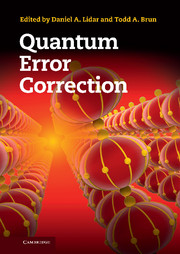Book contents
- Frontmatter
- Contents
- List of contributors
- Prologue
- Preface and guide to the reader
- Acknowledgements
- Part I Background
- Part II Generalized approaches to quantum error correction
- Part III Advanced quantum codes
- 9 Quantum convolutional codes
- 10 Nonadditive quantum codes
- 11 Iterative quantum coding systems
- 12 Algebraic quantum coding theory
- 13 Optimization-based quantum error correction
- Part IV Advanced dynamical decoupling
- Part V Alternative quantum computation approaches
- Part VI Topological methods
- Part VII Applications and implementations
- Part VIII Critical evaluation of fault tolerance
- References
- Index
9 - Quantum convolutional codes
from Part III - Advanced quantum codes
Published online by Cambridge University Press: 05 September 2013
- Frontmatter
- Contents
- List of contributors
- Prologue
- Preface and guide to the reader
- Acknowledgements
- Part I Background
- Part II Generalized approaches to quantum error correction
- Part III Advanced quantum codes
- 9 Quantum convolutional codes
- 10 Nonadditive quantum codes
- 11 Iterative quantum coding systems
- 12 Algebraic quantum coding theory
- 13 Optimization-based quantum error correction
- Part IV Advanced dynamical decoupling
- Part V Alternative quantum computation approaches
- Part VI Topological methods
- Part VII Applications and implementations
- Part VIII Critical evaluation of fault tolerance
- References
- Index
Summary
Introduction
Many of the quantum codes discussed in this book are quantum block codes. Quantum block codes are useful both in quantum computing and in quantum communication, but one of the drawbacks for quantum communication is that, in general, the sender must have her block of qubits ready before encoding takes place. This preparation may be a heavy demand on the sender when the size of the block code is large.
Quantum convolutional coding theory [OT03, OT04, FGG07] offers a paradigm different from quantum block coding and has numerous benefits for quantum communication. The convolutional structure is useful when a sender possesses a stream of qubits to transmit to a receiver. It is possible to encode and decode quantum convolutional codes with quantum shift-register circuits [W09b], the natural “quantization” of a classical shift register circuit. These quantum circuits ensure a low complexity for encoding and decoding while also providing higher performance than a block code with equivalent encoding complexity [FGG07]. Quantum shift-register circuits have the property that the sender Alice and the receiver Bob can respectively send and receive qubits in an “online” fashion. Alice can encode an arbitrary number of information qubits without worrying beforehand how many she may want to send over the quantum communication channel.
- Type
- Chapter
- Information
- Quantum Error Correction , pp. 231 - 260Publisher: Cambridge University PressPrint publication year: 2013



